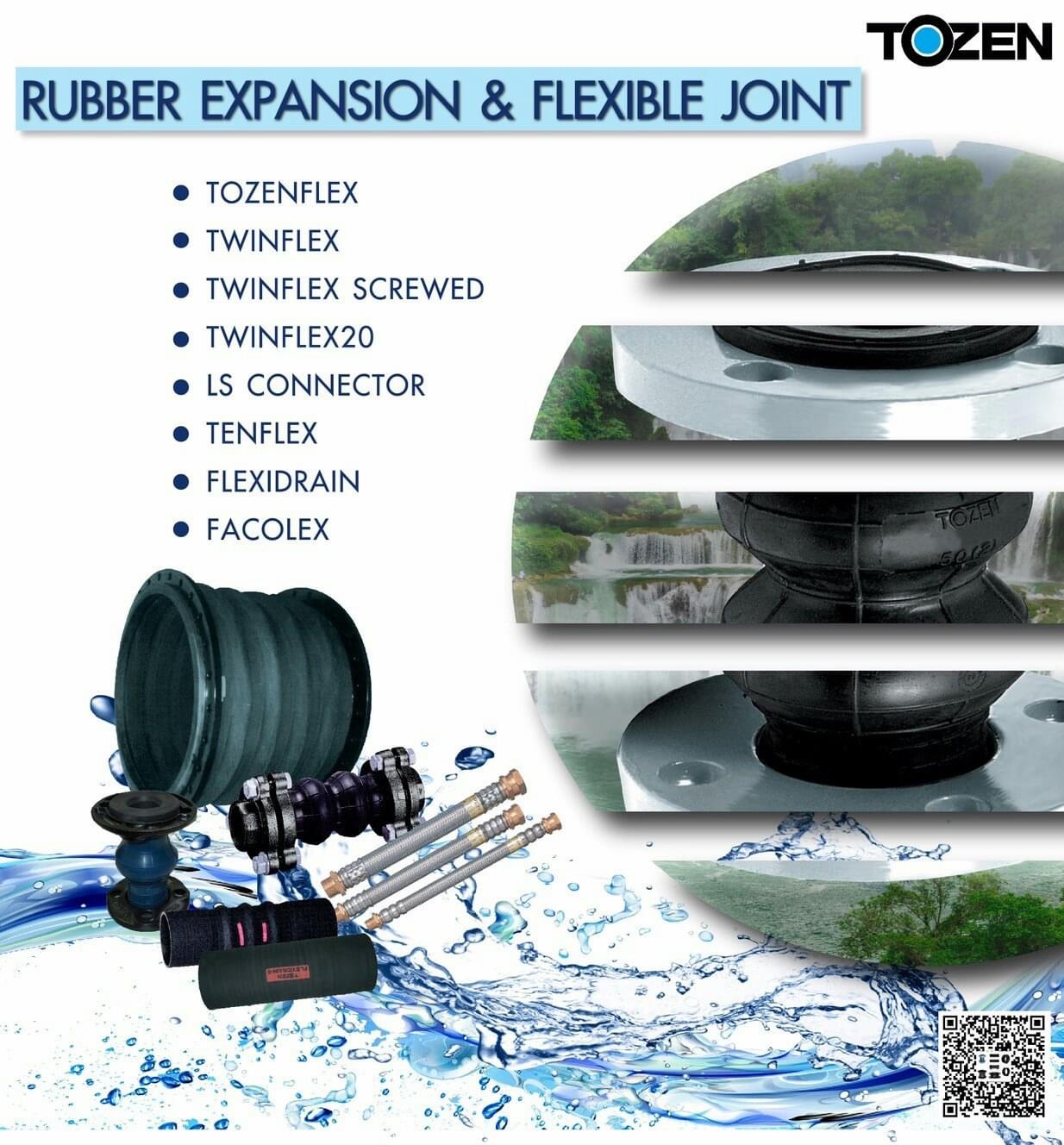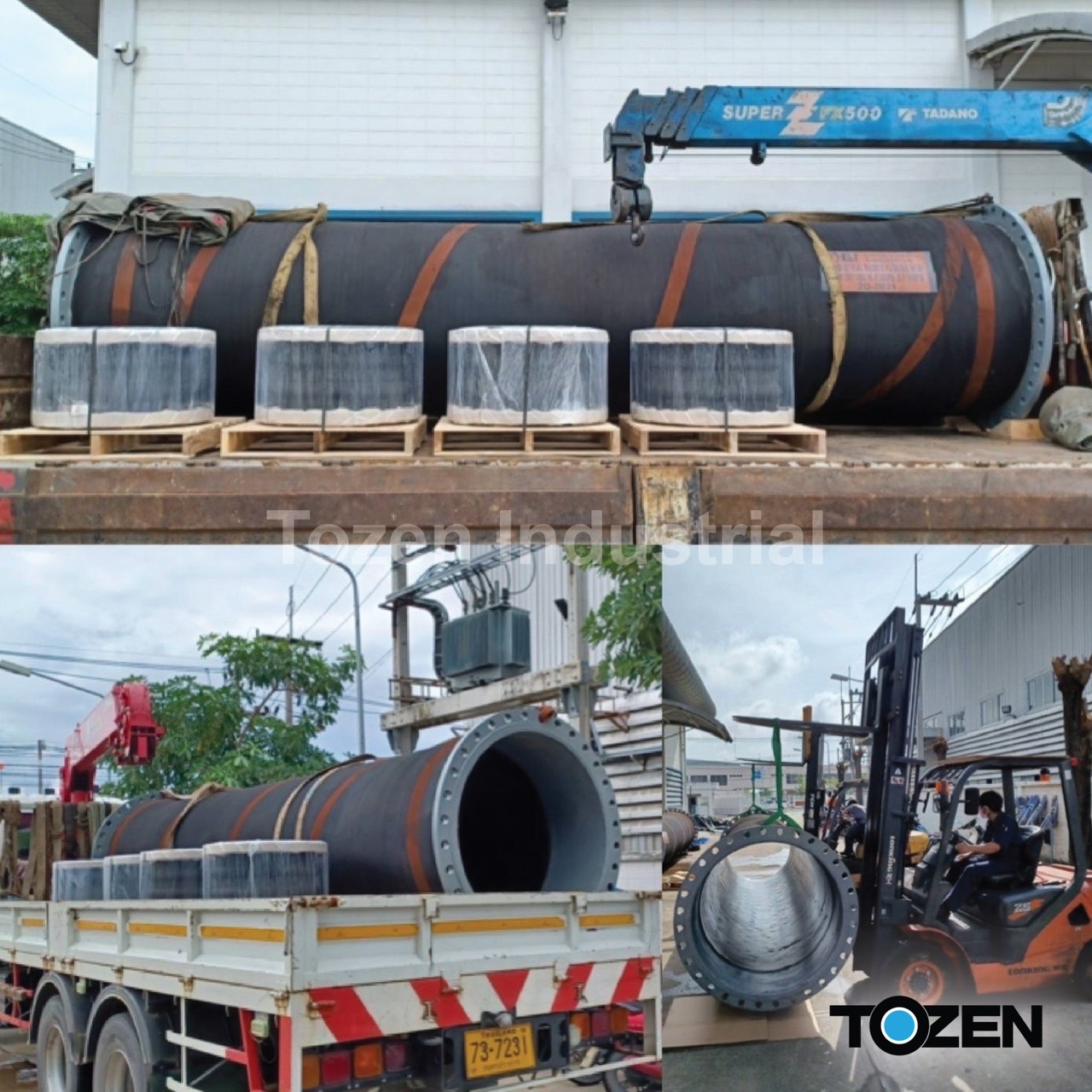Rubber/elastomer flexible connectors have been specified and used for many years by consulting engineers, mechanical contractors, pressure vessel designers, plant engineers and turn-key construction firms.
They are installed to accommodate movement in piping runs, protect piping from expansion and contraction.
Handling Manual for Rubber Joint(ref: KZ1-P-E-810d)
Please use the products after checking max.working pressure and temperature to be within the working conditions.
The products might be damaged by improper operation like complete shut-off operation,etc. Please check the valve position of ‘Open-Close securely when in operation.
- Pay attention to protect the products from damage during transportation and storage. If damaged,do not use the product.
- In case of stroage for a long time, avoid the direct rays of the sun and store the products in the cool and dark place.
- Do not leave the products in the place in more than 40 deg C and excessive moisture for a long time.
- Protect the products from the fire and heat.
- Do not lead to the products.
- For the installation of the joints to the pump, refer to the right illustration and install. When the check valve is installed before the joints from the pump, there is a possibility of some trouble occurrence due to accumulation of weariness by water head pressure always received and receipt of direct water hammer occurs when the pump starts and stops.
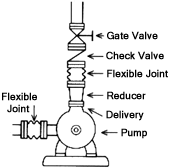
- Install the joints within allowable movements of elongation, compression, eccentricity, angular

- When the joints are in displacement, note for the joints not to touch the structure and equipment (especially sharp edges) near the installation.
- Take measurement and make centering correctly not to add unnecessary outer force (compression, tension, torsion, etc.) when connecting the joints to the pipes.
- When welding or cutting the pipes nearby after installation, protect the joints with a cover like our SPARK GUARD from sparks. In case of the possibility of heat transmission, take some countermeasure like taking the joints off from the pipe, etc.
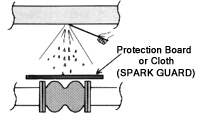
- When installation to the outdoor pipes, make lagging to the joints to prevent the joints body aging.
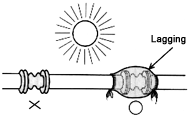
Flange Type Connection
- For the rubber flexible joints, the packing face of the joints might be damaged depending on the counter flange shape. Check the shape of the counter flange with the followings.
 The connection to welding neck flanges (comparatively high pressure flange) is ideal because inner diameter of rubber body and counter flange is almost same and pressure force to the packing is enough.
The connection to welding neck flanges (comparatively high pressure flange) is ideal because inner diameter of rubber body and counter flange is almost same and pressure force to the packing is enough. In case of tongue and groove type flanges, do not use them because they have a fault which the packing is damaged easily due to small contact area with a projection and rubber packing sheet and so the unit area load getting bigger.
In case of tongue and groove type flanges, do not use them because they have a fault which the packing is damaged easily due to small contact area with a projection and rubber packing sheet and so the unit area load getting bigger. In case of slip on counter flanges, it is required for the part of arrow mark to be smoothed or asbestos packing, etc. are required to be used together because the packing will be damaged even though theinner diametre of pipe end is the same as rubber body and if the edge is not smoothed.
In case of slip on counter flanges, it is required for the part of arrow mark to be smoothed or asbestos packing, etc. are required to be used together because the packing will be damaged even though theinner diametre of pipe end is the same as rubber body and if the edge is not smoothed.Fix the installation bolts from the joint body side and tighten the nuts at the counter pipe side. It is more safety for the spring washers to be set to prevent looseness of the bolts. In case of the fully threaded bolt, note of the bolt edge not to protrude extraordinary the joint body side.
Tighten up the installation bolts in even in the diagonal order. Refer to the following table of the space after tightening of the bolts for each joint. The abnormal installation like uneven bolts tightening, etc. will be a factor of damage of the joints.
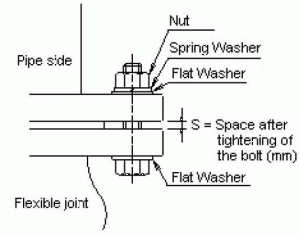
Nominal S = Space after tightening of the bolts (mm) Diameter(mm) Tozenflex Twinflex Dynaflex 10flex Oflex-H 32A~ 80A 1~2 1~2 1~2 1~2 1~2 100A 1~2 1~2 1~2 0.5~1.5 1~2 125A 1~2 1~2 2~3 1~2 1~2 150A 1~2 1~2 2~3 0~1 1~2 200A 2~3 2~3 2~3 0~1 2~3 250A 2~3 2~3 2~3 1~2 2~3 300A 2~3 2~3 2~3 1~2 2~3 350A 2~3 2~3.5 – – – 400A 2~3 – – – – * In case the counter flange is FF type
Fix the installation bolts from the joint body side and tighten the nuts at the counter pipe side. It is more safety for the spring washers to be set to prevent looseness of the bolts. In case of the fully threaded bolt, note of the bolt edge not to protrude extraordinary the joint body side.
SCREW TYPE CONNECTION :
(Screw Type of Tozenflex and Twinflex)
- Remove the installation bolts and take off Flange-A and Socket from the joint body.
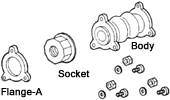
- Set Flange-A to the counter pipe and check the correct direction of Flange-A

- Check smoothness without damage on the thread part of the counter pipe.

- Wind a sealing tape (or other sealing material) the thread part of the counter pipe and tighten up Socket by hand up to certain pitch as much as possible, then set a wrench to the edge of Socket to tighten up well also setting a wrench to the counter pipe.

- Fix the installation bolts from the joint side and tighten up the nuts from the counter pipe side.
- Tighten up the bolts in even in the diagonal order avoiding one side tightening. For the space after tightening of the bolts, refer to the following illustration.
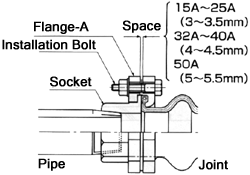
- For the opposite side, set also the same manner as the above 2)-6)
- When the pump operation after the joint installation, the installation bolts are possible to loosen due to the pump vibration. In this case, tighten up the bolts slightly again in even in the diagonal order.
There is reaction force from rubber joints due to the load of the internal pressure,so during the installation of rubber joints,please use the metal fittings to fix the pipe tightly to assure the products work efficiently.
TWINFLEX :
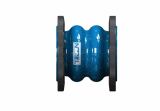 Twinflex is twin sphere rubber connectors. Twinflex is made of neoprene and available from size 15mm to 300mm. For screwed end connection, available sizes are 15mm to 50mm and designed for 10 bar working pressure. For flanged end connections, working pressure shall be 20 bars for size 32mm to 150mm, and 16 bars for size 200mm to 300mm. FCD ANSI 150 and JIS10K floating flanges are standard connectors to Twinflex. Other materials and drilling standards of floating flanges can be supplied upon request. In general, Twinflex provide higher vibration and movement absorption capability than Tozenflex.
Twinflex is twin sphere rubber connectors. Twinflex is made of neoprene and available from size 15mm to 300mm. For screwed end connection, available sizes are 15mm to 50mm and designed for 10 bar working pressure. For flanged end connections, working pressure shall be 20 bars for size 32mm to 150mm, and 16 bars for size 200mm to 300mm. FCD ANSI 150 and JIS10K floating flanges are standard connectors to Twinflex. Other materials and drilling standards of floating flanges can be supplied upon request. In general, Twinflex provide higher vibration and movement absorption capability than Tozenflex.
TWINFLEX 20 :
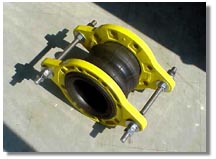 Twinflex is twin sphere rubber connectors. Twinflex is made of neoprene and available from size 15mm to 300mm. For screwed end connection, available sizes are 15mm to 50mm and designed for 10 bar working pressure. For flanged end connections, working pressure shall be 20 bars for size 32mm to 150mm, and 16 bars for size 200mm to 300mm. FCD ANSI 150 and JIS10K floating flanges are standard connectors to Twinflex. Other materials and drilling standards of floating flanges can be supplied upon request. In general, Twinflex provide higher vibration and movement absorption capability than Tozenflex.
Twinflex is twin sphere rubber connectors. Twinflex is made of neoprene and available from size 15mm to 300mm. For screwed end connection, available sizes are 15mm to 50mm and designed for 10 bar working pressure. For flanged end connections, working pressure shall be 20 bars for size 32mm to 150mm, and 16 bars for size 200mm to 300mm. FCD ANSI 150 and JIS10K floating flanges are standard connectors to Twinflex. Other materials and drilling standards of floating flanges can be supplied upon request. In general, Twinflex provide higher vibration and movement absorption capability than Tozenflex.
TWINFLEX 20 :
Tozenflex is single sphere type rubber connectors, and made of EPDM. Available sizes are from 40mm to 300mm. Maximum working pressure is 16 bar for all sizes. FCD ANSI 150 and JIS 10K floating flanges are standard onnectors to Tozenflex. Other materials and drilling standards of floating flanges can be supplied upon request. Tozenflex is commonly suggested for piping systems in general building and industrial services.
PT-LS
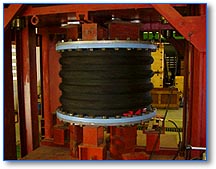 PT-LS is a spool type rubber flexible connectors (or rubber expansion join). Since
PT-LS is a spool type rubber flexible connectors (or rubber expansion join). Since
PT-LS is made by hand-made process, customization is available to fulfill specific/special requirements of sizes (up to 2000mm available), lengths, working pressure (max: 40 bars for small sizes), movements, and connections. Flanged ends, beveled ends, insertion end are available for different pipe connection. PT-LS can be produced for above-ground and underground applications. Standard material is neoprene and EPDM is optional. PT-LS is widely used in general piping systems requiring higher pressure resistance and movement absorption capability where other models are not suitable. PT-LS is popularly used in large-sized piping systems of public waterworks and wastewater projects to solve differential settlement problems (land sinking).
FLEXIDRAIN
Flexidrain is a spool type rubber flexible connector for underground drainpipes. Both flanged type and insertion are available. Flexidrain is made of natural rubber and available from 25 mm to 250 mm. The maximum working pressure is 1 bar.

